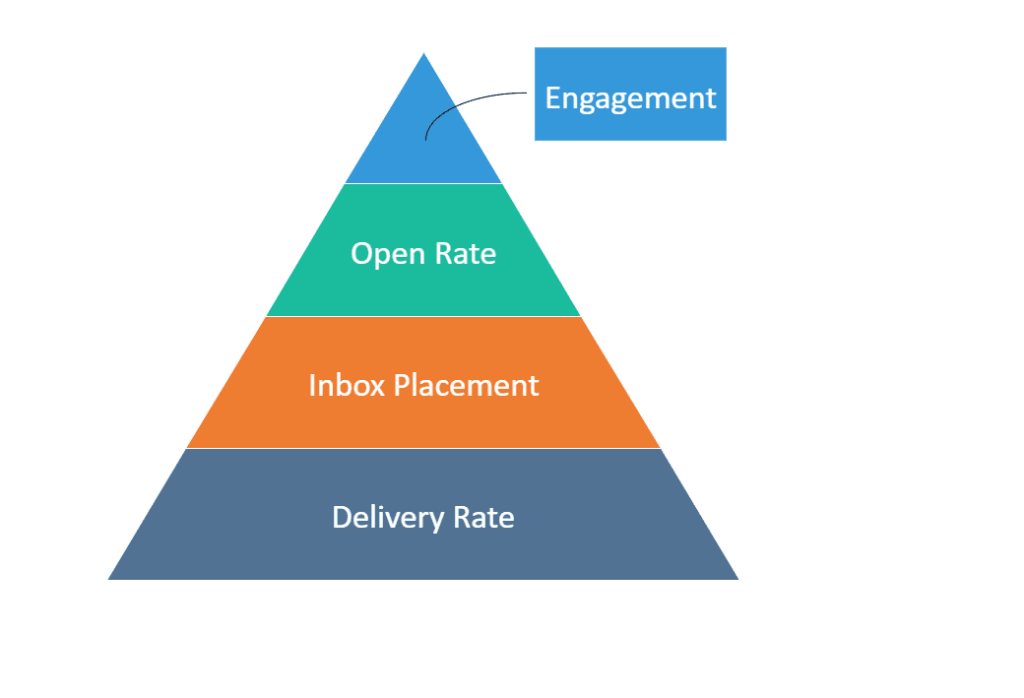Sending emails can feel like an interactive social game. Instead of a high-stakes casino-style game, you are betting on delivery rates, inbox placement, engagement rates — and the ultimate win — conversion rates. While not an exhaustive list of KPIs, The email marketer’s KPI pyramid generally looks like this:

When it comes to maximizing each of these goals, marketers are left searching for ways to optimize their sends. One question that comes up a lot is whether to send plain text email or its HTML counterpart, and how this choice affects KPIs.
Plain-text vs. HTML
HTML comes to mind when you think of sending email marketing campaigns with images and CTA buttons, but did you know that you may be using HTML without realizing it?
Email marketers use HTML every time they:
- Format the font
- Hyperlink text
- Have CTA buttons
- Send graphic-based emails
Advanced email marketers know that part of your job is to give people what they want, rather than what they think they want. While most people think they want images and HTML based emails, according to A/B testing by inbound marketing giant HubSpot, plain-text emails came out on top in various parameters every time against HTML.
B2C email marketing is particularly sensitive to this phenomenon. As the spam and commercial-offer filters of email clients like Gmail and Outlook grow more sophisticated (like Gmail’s “Promotions” tab), B2C email marketers should look to plain-text emails for inbox placement.
Since the first step of the pyramid above is delivery rate, let’s examine how the plain-text vs HTML question plays out in getting your emails to their intended recipients.
Delivery Rate
First things first, you want to make sure you get the email to where it’s going! Even advanced email marketers struggle at times to get past the spam filter. (For tips on how to ensure deliverability, read this article on How Email Authentication Protocols Increase Deliverability.)
HTML and plain-text emails have the same deliverability rate as long as you:
- Include a plain-text version
- Properly code the HTML
Once you’ve passed Level 1 by delivering the email, you must successfully level-up to better your inbox placement.
Inbox Placement
As the second tier of the email marketing KPI pyramid, inbox placement needs to be a part of your strategic game plan.
Just after Gmail introduced the filtering tabs, email marketers were scrambling to avoid censure in the “Promotions” bucket. Getting around this death knell for email marketing endeavors is still really important and one of the key factors to success is sending plain-text emails.
Plain-text emails look like an email from a friend rather than a promotional email. Most of your friends don’t take the time to craft emails with graphics and CTAs.
Here are some other ways to improve inboxing:
- Use different domains for promotional and educational emails.
- Practice micro segmentation by psychometrics, behavior, geolocation, and other important sectors of your audience.
- Use email authentication.
Open Rate & Engagement
Marketo’s study on this topic found about the same open rate for text-based and HTML emails, but text-based emails delivered 11% higher click-to-open and 8% higher click through rates.
Contrary to the Marketo study, a separate study found that open rates actually were impacted negatively for HTML emails. HubSpot found that, while the deliverability rate was the same for graphic and text-based emails, using HTML reduced the open rate by 25%.
Fewer graphics, no GIFS, and a well-written plain-text email version should get your delivery and open rates on the higher side.
But, astute email marketers will wonder, if more people open plain-text emails, does that necessarily mean more people will respond to them? According to research done by HubSpot, although customers surveyed that they prefer to receive HTML emails, plain-text emails had higher click through rates than HTML emails.
Determining the amount of HTML you should use, which types of HTML and graphic-based emails work well for your audience, and which segments respond to plain-text better than HTML can all be done by A/B (split) testing your email variations. Pay attention to delivery rate, inbox placement, open rate and engagement rates in order to measure the performance of your campaigns. Don’t forget to measure success using the four major email marketing KPIs in the pyramid.
Ready to start testing? Discover which type of email will work best for your company by split testing every part of your email from subject headers to graphic-based versus text-based email versions with Ongage’s A/B/C/D testing feature!


















